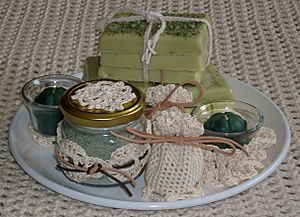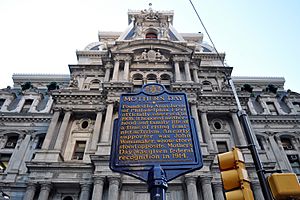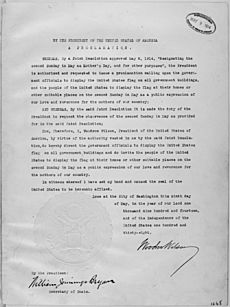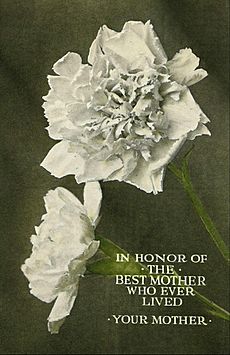Mother's Day (United States) facts for kids
Quick facts for kids Mother's Day |
|
|---|---|

Examples of handmade Mother's Day gifts
|
|
| Observed by | United States |
| Type | Commercial, cultural, religious |
| Observances | Holiday card and gift giving, churchgoing accompanied by the distribution of carnations, and family dinners |
| Date | Second Sunday in May |
| 2024 date | May 12 |
| 2025 date | May 11 |
| 2026 date | May 10 |
| 2027 date | May 9 |
| Frequency | Annual |
| Related to | Father's Day |
Mother's Day is a special holiday in the United States celebrated every year on the second Sunday of May. It's a day to honor mothers, grandmothers, and other mother figures. People celebrate the love and hard work mothers give to their families and communities.
The holiday was started by a woman named Anna Jarvis. The very first Mother's Day celebration was held at a church in Grafton, West Virginia, on May 10, 1908. Today, people celebrate by giving cards and gifts, going to church, and enjoying family meals together. It's a day similar to other family holidays like Father's Day and Grandparents Day.
While many countries celebrate Mother's Day, they may have different traditions and celebrate on different dates. You can learn more about the global celebration at Mother's Day.
Contents
The Story of Mother's Day
Early Ideas for a Day for Mothers
Long before Mother's Day became an official holiday, people had ideas for a day to honor mothers. In the 1800s, after the American Civil War, groups of women worked to promote peace. One of these women was Ann Jarvis, the mother of the holiday's founder.
In 1868, Ann Jarvis organized a "Mother's Friendship Day." Its goal was to bring together families that had been on opposite sides during the war. She hoped to make this an annual event to remember mothers, but she passed away before it could happen.
Another important person was Julia Ward Howe. In 1872, she called for a "Mother's Day for Peace." She wanted mothers around the world to work together to prevent wars. Her celebration was held in Boston for about ten years.
There were other local celebrations, too. For example, in Albion, Michigan, a church began setting aside the second Sunday in May to honor mothers in the 1880s.
How Mother's Day Became Official
The Mother's Day we celebrate today was started by Anna Jarvis, Ann Jarvis's daughter. After her mother died in 1905, Anna wanted to create a day to honor the sacrifices mothers made for their children.
With help from a Philadelphia businessman named John Wanamaker, Anna organized the first official Mother's Day celebration. It took place on May 10, 1908, at a church in Grafton, West Virginia, where her mother had taught Sunday school. A larger event was also held in one of Wanamaker's stores in Philadelphia.
The idea quickly became popular. Anna Jarvis campaigned to make Mother's Day a national holiday. In 1910, West Virginia was the first state to officially recognize it. Other states soon followed.
Finally, in 1914, the U.S. Congress passed a law making the second Sunday in May Mother's Day. President Woodrow Wilson then made an official announcement, declaring it a national holiday.
Why Is It "Mother's Day"?
Have you ever wondered why Mother's Day is spelled with an apostrophe before the "s"? The founder, Anna Jarvis, was very specific about this. She wanted the name to be Mother's Day (singular), not Mothers' Day (plural).
She said it should be a day for each family to honor its own mother. It wasn't meant to be a day for celebrating all mothers everywhere at once, but a more personal day for your own mom. This is the spelling that President Woodrow Wilson used when he made it a national holiday.
How People Celebrate Mother's Day
Today, Mother's Day is celebrated in many ways. Common traditions include going to church, having family dinners, and giving gifts. It is one of the biggest holidays for sending greeting cards in the United States.
Giving Flowers, Especially Carnations
Flowers are a very popular gift for Mother's Day, and the carnation is the holiday's traditional flower. This tradition started with Anna Jarvis, who gave away 500 carnations at the first celebration in 1908. She chose them because they were her mother's favorite flower.
Over time, a custom developed for wearing a carnation on Mother's Day. People would wear a colored or pink carnation to honor a mother who was still alive. They would wear a white carnation to remember a mother who had passed away. Today, many other flowers like roses are also popular gifts.
A Holiday's Popularity and Problems
Mother's Day is a very popular holiday, which means companies sell a lot of flowers, cards, and gifts. But the founder, Anna Jarvis, was not happy about this.
Only a few years after she started the holiday, she began to protest against how commercial it had become. She believed that people should show their love through handwritten letters and kind actions, not by buying expensive, pre-made gifts and cards. She thought store-bought cards were a lazy way to show appreciation.
Anna spent the rest of her life and all of her money fighting against the commercialization of Mother's Day. She was even arrested during a protest in 1948. She once said she wished she had never started the day because it had become something she didn't recognize.
Today, Mother's Day is one of the biggest holidays for businesses in the U.S. People spend billions of dollars on flowers, gifts, and taking their moms out to eat.
Mother's Day in Sports
Professional sports leagues in the United States often honor Mother's Day. It is common to see athletes using pink equipment, such as pink bats in baseball or pink towels in football, to show appreciation for mothers during games held on Mother's Day weekend.
See also
- Father's Day
- Mōdraniht
- National Grandparents Day




